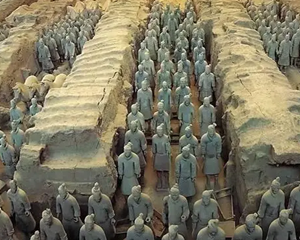Speaking of tombs, did you know that China has some impressive ones just like Egypt?
说到陵墓,你知道吗,中国也有一些和埃及一样令人印象深刻的陵墓?
That's right. China's first emperor Qin Shi Huangdi, who ruled from 221 B.C. to 210 B.C., had a large tomb constructed for himself and an army of warriors.
是的。中国第一位皇帝秦始皇(公元前221年至公元前210年在位)为自己和一支军队建造了一座大陵墓。
This tomb complex was found in 1974 by some peasants after being hidden from the world for over 2,000 years.
这个墓群在被隐藏了2000多年后,于1974年被一些农民发现。
Wait, wait, wait! What were you saying about an army of warriors?
等等,等等,等等!你刚才说什么军队?
Well, not exactly a real army, these were actually terracotta warrior statues made out of baked clay.
嗯,并不是真正的军队,实际上是由陶土制成的兵马俑。
What do you mean?

See, the emperor believed that if he had his people build these statues and have them placed within his tomb, the warriors would be able to protect him in the afterlife.
这位皇帝相信,如果他发动他的臣民建造这些陶俑,并把它们放在他的陵墓里,这些士兵就能在他死后保护他。
Archaeologists estimate that over 7,000 terracotta warriors are within the tomb, and that it took over 700,000 people to construct the tomb and statues.
据考古学家估计,陵墓中约有7000多个兵马俑,而建造陵墓和陶俑共动用了70多万人。
That's really impressive.
真让了不起。
What's even more amazing is that each statue was custom-made to have its own unique face and design, that's a lot of work.
更神奇的是,每个陶俑都是定制的,有自己独特的面孔和设计,这需要大量的工作。
And besides the terracotta army, the tomb held many cultural artifacts and treasures, such as tools and weapons.
除了兵马俑,陵墓里还有许多文物和宝藏,比如工具和武器。












